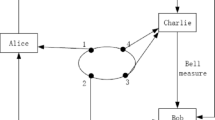Abstract
For actual voting, the most important thing is voter privacy. Ring signatures widely used in electronic voting protocols to protect voter privacy due to unconditional confidentiality. It has been found that electronic signature protocols based on mathematical complexity are not secure. We propose an electronic voting protocol based on quantum ring signatures. The generalized GHZ state is prepared and distributed by a trusted third party (TTP), so that all users in the ring can effectively act as voters or verifiers. Users in the ring and TTP use quantum key distribution technology to share keys and encrypt messages. The entire protocol uses one-time secret technology to further enhance the security of the voting process.

Similar content being viewed by others
References
C.H. Bennett, G. Brassard: Public key distribution and coin tossing. In: Proceedings of the IEEE international conference on computers, systems and signal processing, Bangalore, pp. 175–179. IEEE, New York (1984)
Zhang, Q., Yin, J., Chen, T.Y., Lu, S., Zhang, J., Li, X.Q., Yang, T., Wang, X.B., Pan, J.W.: Experimental fault-tolerant quantum cryptography in a decoherence-free subspace[J]. Phys. Rev. A. 73(2), 020301 (2006)
Wang, Q., Zhou, X.Y., Guo, G.C.: Realizing the measure-device-independent quantum-key-distribution with passive heralded-single photon sources. Sci. Rep. 6, 35394 (2016)
Farouk, A., Omara, F., Zakria, M., et al.: Secured IPsec multicast architecture based on quantum key distribution[C]. The International Conference on Electrical and Biomedical Engineering, Clean Energy and Green Computing. 38–47 (2015)
Chang, Y., Xu, C., Zhang, S., Yan, L.: Controlled quantum secure direct communication and authentication protocol based on five-particle cluster state and quantum one-time pad. Chin. Sci. Bull. 59, 2541–2546 (2014)
Bebrov, G., Dimova, R.: Efficient quantum secure direct communication protocol based on Quantum Channel compression. Int. J. Theor. Phys. 59, 426–435 (2020)
Javelle, J., Mhalla, M., Perdrix, S.: New protocols and lower bounds for quantum secret sharing with graph states[C]. In: Conference on Quantum Computation, Communication, and Cryptography, pp. 1–12. Springer, Berlin, Heidelberg (2012)
Ming-Kuai, Z.: Improvement of the semi-quantum secret sharing protocol of specific bits. Int. J. Theor. Phys. 59, 1772–1776 (2020)
Yang, Y.G., Sun, S.J., Xu, P., Tian, J.: Flexible protocol for quantum private query based on B92 protocol[J]. Quantum Inf. Process. 13(3), 805–813 (2014)
Bin, L., Fei, G., Wei, H., et al.: QKD-based quantum private query without a failure probability[J]. Sci. China Phys. Mech. Astron. 58(10), 100301 (2015)
Yu, K.F., Yang, C.W., Liao, C.H., Hwang, T.: Authenticated semi-quantum key distribution protocol using bell states[J]. Quantum Inf. Process. 13(6), 1457–1465 (2014)
Boyer, M., Gelles, R., Kenigsberg, D., et al.: Semiquantum key distribution[J]. Phys. Rev. A. 79(3), 032341 (2009)
Gao, X., Zhang, S., Chang, Y.: Cryptanalysis and improvement of the semi-quantum secret sharing protocol[J]. Int. J. Theor. Phys. 56(8), 2512–2520 (2017)
Gao, X., Chang, Y., Zhang, S.B., et al.: Quantum private query based on bell state and single photons[J]. Int. J. Theor. Phys. 57(7), 1983–1989 (2018)
Thapliyal, K., Sharma, R.D., Pathak, A.: Orthogonal-state-based and semi-quantum protocols for quantum private comparison in noisy environment[J]. International Journal of Quantum Information. 16(05), 1850047 (2018)
Shukla, C., Thapliyal, K., Pathak, A.: Semi-quantum communication: protocols for key agreement, controlled secure direct communication and dialogue[J]. Quantum Inf. Process. 16(12), 295 (2017)
Gottesman D., Chuang I.: Quantum digital signatures[J]. arXiv. preprint quant-ph/0105032 (2001)
Zeng, G., Keitel, C.H.: Arbitrated quantum-signature scheme[J]. Phys. Rev. A. 65(4), 042312 (2002)
Li, Q., Chan, W.H., Long, D.Y.: Arbitrated quantum signature scheme using bell states[J]. Phys. Rev. A. 79(5), 054307 (2009)
Tian-Yin, W., Qiao-Yan, W.: Fair quantum blind signatures[J]. Chinese Physics B. 19(6), 060307 (2010)
Wen, X., Tian, Y., Ji, L., et al.: A group signature scheme based on quantum teleportation[J]. Phys. Scr. 81(5), 055001 (2010)
Rivest, R.L., Shamir, A., Tauman, Y.: How to leak a secret[C]. In: International conference on the theory and application of cryptology and information security, pp. 552–565. Springer, Berlin, Heidelberg (2001)
Acknowledgments
This work is supported by the Key Research and Development Project of Sichuan Province(No.2020YFG0307, No.20ZDYF2324, No.2019ZYD027, No.2018TJPT0012), the National Natural Science Foundation of China (No.61572086, No.61402058), the Innovation Team of Quantum Security Communication of Sichuan Province (No.17TD0009), the Academic and Technical Leaders Training Funding Support Projects of Sichuan Province (No. 2016120080102643), the Application Foundation Project of Sichuan Province (No.2017JY0168), the Science and Technology Support Project of Sichuan Province (No.2018GZ0204).
Author information
Authors and Affiliations
Corresponding author
Additional information
Publisher’s Note
Springer Nature remains neutral with regard to jurisdictional claims in published maps and institutional affiliations.
Rights and permissions
About this article
Cite this article
Qiu, C., Zhang, S., Chang, Y. et al. Electronic Voting Scheme Based on a Quantum Ring Signature. Int J Theor Phys 60, 1550–1555 (2021). https://doi.org/10.1007/s10773-021-04777-1
Received:
Accepted:
Published:
Issue Date:
DOI: https://doi.org/10.1007/s10773-021-04777-1




